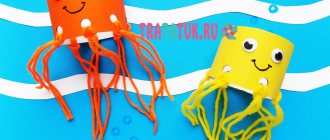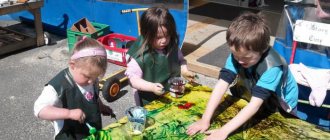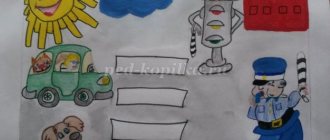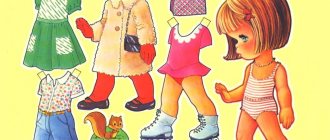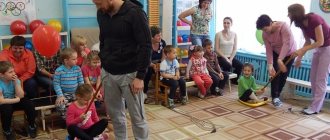Didactic game “Dress the doll”
The gaming material is intended for individual and independent study. Children 2-7 years old can play.
The purpose of the didactic game “Dress the Doll” is to expand the understanding of the structure of the human body, secondary sexual characteristics, seasonal types of wardrobe, and the order of putting on clothes.
Tasks:
- developing basic knowledge about the structure of the human body and the division of wardrobe by season and purpose;
- expanding ideas about daily putting oneself in order, about the peculiarities of the seasons of the year;
- fixing the correct order of putting on wardrobe items;
- getting an idea of the division of the wardrobe into girls’ and boys’;
- gaining self-care skills;
- development of attention, logic, imagination, speech skills;
- increased curiosity, desire for knowledge;
- improving visual perception and finger motor skills, preparing for school activities;
- development of communication skills, formation of a positive attitude with organized actions.
For the didactic game “Dress the doll for a walk,” make two dolls of different sexes from cardboard or felt. For each doll, prepare a wardrobe:
- boys' seasonal clothing - two jackets (for autumn and winter), two hats (winter and autumn), sweater, T-shirt, shirt, tights, pants, shorts, cap, mittens, boots, sneakers;
- girls' seasonal clothing - two jackets (for autumn and winter), two hats (winter and autumn), pullover, dress, sundress, top, skirt, tights, shorts, pants, Panama hat, mittens, boots, boots, sandals;
- a set of clothes by color (coat, dress, hat, bows, boots of different colors);
- a set of work suits (doctor, fireman, gardener, builder, pilot);
- a set of national costumes of Russia (Russian, Chukchi, Chechen, Bashkir, Mordovian, Kalmyk, Tatar).
Attach Velcro or fastening inserts to clothing to make it easy to attach to dolls.
Handmade clothing and outfits from scrap materials
A designer toy undoubtedly requires unique, beautiful and original clothes for dolls. Professional puppeteers approach the formation of a doll's image with extraordinary care and ingenuity. Wardrobe items can be made from traditional materials (velvet, satin, lace) and from very unusual materials, such as cotton wool, paper, foil. Tights, socks, old ties or napkins are actively used. Much in this case depends on the author’s idea and the functionality of the doll:
- Sets of collectible and exhibition dolls are neat, detailed clothes, finely crafted by the author. Artful outfits can be intricately cut, whimsically decorated, made in a vintage style, artificially aged or stained;
- Clothes for an ordinary play doll can be sewn from scraps or old things available in the house. In this case, it is enough to find drawings, templates, simple patterns for cutting and knitting cute doll outfits on numerous thematic websites;
- The figurine, which is part of the decor of gift packaging, can be dressed in a skirt made of corrugated paper, flowers, lace, or a fur coat made of cotton wool or felted wool.
Game options
When organizing the didactic game “Dress the doll according to the season,” clearly and emotionally explain the information to the children and show the actions. Once the player has mastered the skills of putting together a wardrobe, move the game from an organized event to a free process.
Name the clothes
Game for preschoolers 3-4 years old. Teaches you to recognize and correctly name wardrobe items.
Show me the thing. The child must name it, tell who (a boy or a girl) and when it should be worn.
Sort out your clothes
The game teaches you to separate wardrobe items into girls' and boys'.
In the story, the dolls were invited to a festive event, but they scattered their clothes around the room, and now they can’t figure out which is whose. The player’s task is to help the dolls sort things out: put them to the right for a girl, to the left for a boy. When the child has distributed the clothes correctly, let him dress each doll smartly.
Choose by color
The game develops the skill of selecting clothes based on the same colors and helps to reinforce the names of colors.
In the story, it’s the doll’s birthday, and she asks you to help her choose other things to match her dress, so that the whole outfit is the same color. For example, the dress is red. This means that the child must find, among the playing materials, a red coat, shoes, and a bow.
Draw an outfit
The game is suitable for preschoolers 3-5 years old, develops artistic skills and fine motor skills.
Invite the student to trace the outline of an item of clothing, then color it. For example, let him draw a beautiful pattern on a sweater.
Dress your doll according to the season
The lesson reinforces the sequence of actions when putting on clothes. The child learns to distinguish between seasonal items, bottoms and tops, and cultivates careful handling of the wardrobe.
Remind your student that there are four seasons and that you need to dress depending on the weather. The activity can be divided by season. During the didactic game “Dress the doll for a walk in winter,” the preschooler must learn that it is cold outside, so it is necessary to dress warmly. Ask what item you need to wear. The child must answer that it is warm.
The gameplay is similar to the other seasons of the year.
National outfit
The manual “Dress the doll in a national costume” develops patriotism and creates an idea of the variety of outfits of different nationalities in Russia. During the game, preschoolers highlight the nuances of clothing and accessories, identify similarities and differences between costumes.
Work clothes
The manual “Dress a doll according to its profession ” forms an idea of the variety and purpose of work suits. Children identify the features of a wardrobe, learn what function this or that item performs. For example, a builder has a helmet; it protects his head from injury.
Jewelry and accessories
A doll's look will seem dull and artificial without decorations, small fittings and accessories for doll clothes. To make the outfit look complete, you need to pay attention to small details:
- Doll accessories are not only a functional necessity, but also complete the entire look. Colored large buttons will give the toy a mischievous and spontaneous look, and lacing, rivets and a zipper will tell about the independent, free character of the doll;
- Decorative decorations are a mandatory attribute of historical doll clothing. All kinds of rhinestones, beads, seed beads, and glass beads have been decorating the costumes of aristocrats, as well as the dresses of rich ladies, for hundreds of years. In addition, decorated clothes for dolls are complemented with miniature removable jewelry: earrings, tiaras, brooches, necklaces;
- Additional accessories for dolls are also often used as the finishing touch to a toy’s outfit. A designer doll-musician cannot do without a miniature violin or trumpet, an angel doll needs snow-white wings, a shoemaker needs a leather apron and a hammer, and a languid lover needs a photograph or portrait of his lady love.
What materials are safe for children?
Despite the fact that adults are often interested in clothes for toys, the main fans of doll clothes are still children. Therefore, in addition to beauty and brightness, the highest safety requirements are imposed on the doll outfit.
- One of the main conditions for clothing a children's toy is its naturalness and environmental friendliness. The materials from which outfits for dolls are made must be hypoallergenic, painted with paints that are safe for health, not irritate the delicate skin of the child, and also do not contain harmful substances and heavy metals;
- If there are printed images, pictures and drawings on the clothes, they should not fall off or stain the skin during the game;
- The fabric should be soft and pleasant to the touch. Doll clothes for very young children should not have small, easily torn parts, buttons, beads or sharp fittings.
It’s worth mentioning separately about clothes for interior dolls. Doll outfits for the interior are often objects of real art. Since the purpose of such toys is purely aesthetic, the costumes of this type of doll are not intended for daily play. Clothes are often permanent, but hand washing with the doll is often allowed (for example, if the toy is made of knitwear or textiles) or dry gentle cleaning.
Interior clothing for dolls is a continuation of the author's idea and a collectible. Among fans of interior design toys, outfits become a source of new ideas; doll clothes appear for inspiration and special artistic pleasure. For example, the creation of dolls in the image of passionate Spanish flamenco dancers can be continued in a whole collection of doll dance clothes or costumes from different peoples of the world.
However, we should not forget that if an outfit is sewn by inept children’s hands for a perhaps not unique, but favorite toy, it contains exactly the same creativity as in an expensive designer outfit by a master.
